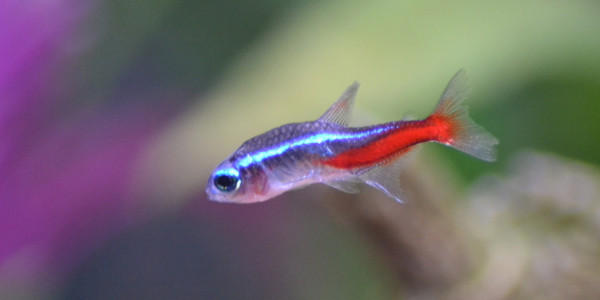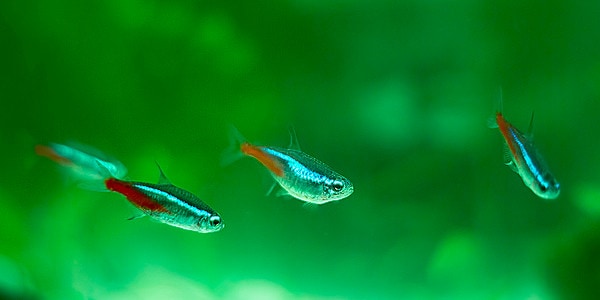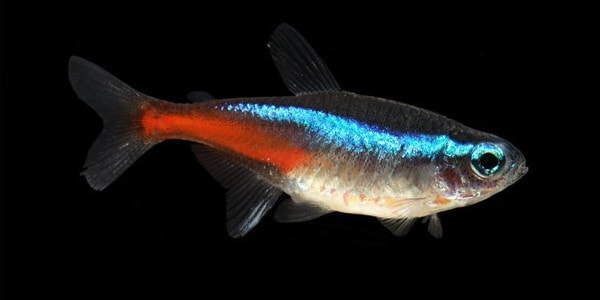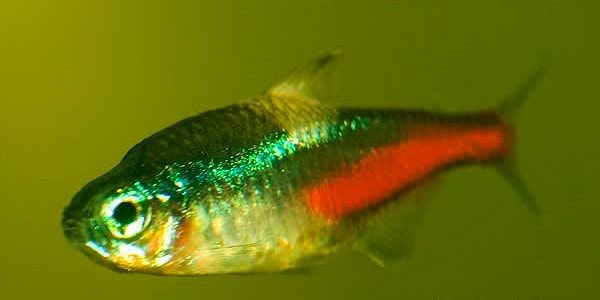Neon Tetra disease is a common and unfortunate obstacle many aquarium hobbyists will encounter.
While the disease is most prevalent in Neon Tetra, it can affect other species in your aquarium.
There are numerous symptoms and immediate signs you can identify to confirm the infection in your aquarium, but sadly there is no common cure to apply that will remove the disease, as a result the main treatment practice is to remove the infected fish immediately to preserve the remainder of your aquarium.
With this in mind, the key to preserving a healthy and safe aquarium is proactive management and preventative measures to help sustain and clean and thriving aquarium.
Table of Contents
Causes of Neon Tetra Disease
An organism called Pleistophora hyphessobryconis causes Neon Tetra Disease.
The disease is communicated throughout the fish in the aquarium once fish consume the dead bodies of other fish in the tank or live food servings such as Tubifex, which can act as an intermediary carrier of the disease.
Once the fish in your tank consume the deceased particles, parasitic spores enter the body of the fish and begin to consume the healthy host.
As the disease progresses, cysts begin to show on the infected hosts and they begin to deteriorate from the inside out.
This is most commonly evidenced by a pale white color on the infected fish.

Symptoms of Neon Tetra Disease
The disease has many key identifying traits that will alert the attentive aquarist to the issue.
These symptoms include the obvious physical effects like the cysts on the body of the infected fish.
However, the fish will also begin to lose color, show difficulty in swimming, or, in more extreme cases, the shape of the fish’s spine may also become curved.
There is also the probability of a second infection like fin rot or bloating of the infected species.
Key Indicator of Neon Tetra Disease
The first key indicator of Neon Tetra Disease in your aquarium is restlessness of infected fish.
For example, you’ll notice that the infected host will no longer school or swim with its fellow inhabitants.
They will often break off from the group or swim erratically.
This unprecedented move of individuality in a fish known for schooling is the result of the disease beginning to affect the fish.
Following suit, the color and fins will also be most clearly effected by the disease, however, this is in more advanced stages of the infection.
Do your best to spot the issue early on to prevent widespread contamination of your aquarium.
Fishes that can be affected
Neon Tetra Fish are the most common victims of this disease, however, other fish such as Angelfish, Barbs, and Rasboras have also been known to contract the disease.
The only fish species that does show resistance to the infection is Cardinal Tetras.

Prevention and Treatment
Unfortunately, there is no medicine or treatment to administer to infected fish with Neon Tetra Disease.
The main protocol is to separate the infected inhabitants and to euthanize them to prevent further contamination.
The best response one can have to this issue is to take preventative measures against a second outbreak.
An aquarist can do this by maintaining high quality water levels with regular cleaning, especially after the initial outbreak.
In addition, one should also be very strict in purchasing his or her fish to identify the above symptoms in pet stores before you purchase and bring them to your home aquarium.
As a best practice, you can also quarantine new fish from your aquarium for a couple of weeks before introducing them to the new environment.
In the event that you do spot any sort of infection, do your best to immediately remove the fish from the aquarium as early as possible.

Frequently Asked Questions
Is it possible to completely eradicate the disease from a tank even after infection?
Neon Tetra Disease is highly contagious due to the way it is communicated between fish species.
It is of the utmost importance to immediately quarantine infected fish and to maintain high quality water levels and cleanliness to not further damage the eco system.
The tank is not so much as the issue of reintroducing the disease as is the fish communicating it amongst each other.
Take other preventative measures such as maintaining healthy water levels in temperature and current as to not agitate your fish further.
Do all Neon Tetras carry this disease?
No, the disease is communicated amongst many different species and is the result of fish consuming other deceased fish tissue.
The main factor to avoid this disease is to never purchase fish that appear to be sick prior to your care.
What are some of the best ways to spot the disease early on?
Restlessness among fish, discoloration, fin rot, and other physical signs can be seen among infected hosts.
Once identified, immediately remove them from your aquarium.
Take precaution and stop infection
Hope I’ve managed to clear the air on Neon Tetra Disease.
It’s important for you to learn the symptoms so that you can make early intervention so as not to cause an outbreak in your tank.
Is The Neon Tetra Disease Treatable?
Neon tetra disease is a very common condition that affects fish species. Although most of the other conditions are treatable, this one disease is very bad for the fish’s health. The condition isn’t treatable if the fish gets infected with it. If a neon tetra is affected by the condition, they are immediately isolated in another fish tank or euthanized. If the same happens in a community tank, it is important that you immediately separate them from the tank to avoid spreading the disease.
What Should I do if my fish is suffering from Neon Tetra Disease?
Although neon tetra disease isn’t curable, it is preventable. If a neon tetra contracts the disease, it is important to immediately remove them from the tank since the infection is highly contagious. So, if you want the best for your fish and the tank as a whole, prevention is the best route.
The best way to ensure that is by quarantining all the new fish you introduce to the tank. This way, you reduce the risks of spreading the health issues further to other fish in the tank. Avoid adding them to the tank if you find something amiss with the new fish during quarantine.
Does an Anti-Bacterial Treatment work?
If you are assured that it is neon tetra disease, an anti-bacterial treatment can work well. Even if it is not neon tetra disease and a simple bacterial infection, a thorough anti-bacterial treatment can work magic. It can help reduce the risks of further infections and inhibit the spread.
Is it worth it?
Yes, anti-bacterial treatments work and eliminate further chances of spread. Ideally, anti-bacterial treatments like API Melafix Antibacterial Fish Remedy. The treatment is effective and affordable, making this ideal for beginner aquarists. The treatment also helps heal any injuries and open wounds on the fish body.
Is Cardinal Tetra Disease the Same Symptoms and Disease?
Cardinal tetra disease and neon tetra disease exhibit similar symptoms and impacts on the tank. They can show similar signs of distress and fatigue and even be under stress inside the tank. So, make sure you look out for any sudden changes to the fish’s behavior and remove them from the tank if needed.
Since these diseases are quite contagious and spread a lot quicker, you must treat them with caution and, if needed, euthanize them, so they don’t have to suffer in silence.
Can Guppies Get Neon Tetra Disease?
Other fish species like angelfish, rasboras and barbs have contracted neon tetra diseases quite frequently. However, there are not many reports showing guppies contracting the disease.
Since neon tetra disease spreads very rapidly, it isn’t surprising that they can affect guppies if kept in close contact. The disease can also spread if the guppies eat the infected neon tetras in the tank.
Can Bettas Get Neon Tetra Disease?
Like guppies, even bettas run into the risks of contracting the neon tetra disease if they remain in close contact with the infected neon tetra fish. Since bettas are already very territorial, we’d recommend that you keep them away from the neon tetras and keep them alone in the tank or with the same species and in limited numbers.
If they are in a community tank and a neon tetra is infected, remove the infected fish immediately. Follow it up with a thorough anti-bacterial treatment to get rid of any kind of remnant bacterial infection in the water.
Is Neon Tetra Disease Contagious?
Neon tetra disease is highly contagious and can infect multiple fish species in the tank in a matter of seconds or minutes. However, keep in mind that the disease is non-communicable to humans. So, you can treat the infected tank by yourself without worrying about your health.
Since the disease progresses rapidly, you must find the infected fish immediately and remove them from the tank as early as possible. The quicker you remove them, the easier it becomes to contain the spread and ensure that the other fish are in the best of health.
What is False neon tetra disease?
Neon tetra disease exhibits very similar symptoms to a staple bacterial infection. In such cases, it becomes very challenging for the aquarists to distinguish between the two and often conclude the symptoms as neon tetra disease. In such cases, there are chances for the condition to be a false neon tetra disease, which is more like a bacterial infection and not as severe.
False neon tetra disease is treatable and doesn’t kill the fish. However, even for these, an early diagnosis is important so that the fish can be isolated and treated with the right antibacterial treatment that they need.
No related posts.


6 thoughts on “Neon Tetra Disease – Cases, Symptoms, Prevention & Treatment”
Largest neon of a group of six is swimming almost in a vertical position and looks like it’s struggling to stay horizontal the other five fish or just calmly swimming around together this one seems to be more in the upper part of the water, and just seems to be acting weird I’m wondering if this might be that diseases as mentioned above
What do you do with the infected tetras?
Can over feeding glowlight tetra can cause them to get infected?
No. But over feeding creates ammonia and makes them more susceptible to disease.
It was very well written artical on tetra. Your artical gave me more information about how to treat tetra while suffering from diseases and how to take care of them. i love the way how you mention about their symptoms and prevention. When choosing a prepared food for my glowlight tetra, I would recommend TetraMin Tropical Flakes. I have always had success with this food in the past and it is known for its high-quality ingredients.
When the tank is empty of fish when can you start reintroducing new tetras without them getting the diesease again?